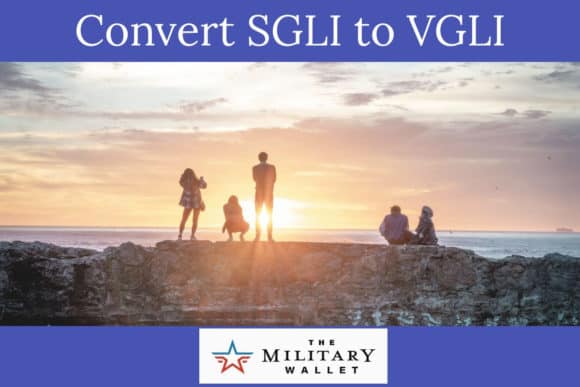One of the most important things you need to consider when making the transition from military service to civilian life is how much life insurance you need and to make sure you are covered when you leave active duty service. Some military members may need more life insurance than civilians, or it may be the opposite for your situation.
Life insurance is there to make sure your family will have a source of income if you are no longer alive to provide for them. The last thing you want is to leave active duty service and leave your family without a lifeline.
Thankfully, there is a group life insurance program in place that allows military veterans to transfer their Servicemembers Group Life Insurance (SGLI) to a similar low-cost group life insurance program called Veterans’ Group Life Insurance (VGLI).
Comparing SGLI and VGLI
There are two important distinctions between SGLI and VGLI:
- Eligibility, and
- Cost
The first is who is eligible for either program. While SGLI is a group life insurance program covering active servicemembers, VGLI is a group life insurance program for military veterans, with premiums that are based on the veteran’s age.
The other notable distinction is cost. SGLI is a low-cost group life insurance policy. Everyone who is eligible for SGLI pays the same premiums, regardless of their age, gender, health, or other factors. VGLI premiums, however, are based on age.
Comparing SGLI and VGLI Premiums
SGLI premiums are 6 cents per thousand dollars of coverage. Servicemembers can purchase coverage in $50,000 increments up to a maximum of $400,000 (maximum coverage comes out to $24 per month). Servicemembers also buy into the TSGLI program for $1 per month. The Traumatic Servicemembers Group Life Insurance program provides cash assistance for servicemembers who are injured while on active duty.
You can see the full range of SGLI premiums:
| SGLI Coverage Amount | Monthly Premium Rate | TSGLI Premium | Total Monthly Premium Deduction |
|---|---|---|---|
| $400,000 | $24 | $1 | $25 |
| $350,000 | $21 | $1 | $22 |
| $300,000 | $18 | $1 | $19 |
| $250,000 | $15 | $1 | $16 |
| $200,000 | $12 | $1 | $13 |
| $150,000 | $9 | $1 | $10 |
| $100,000 | $6 | $1 | $7 |
| $50,000 | $3 | $1 | $4 |
VGLI premiums, however, can be purchased in $10,000 increments, and premiums vary by age. Here is an abbreviated table showing VGLI premiums (note: for space reasons, we chose to show premiums in $50,000 increments, even though VGLI can be purchased in $10,000 increments):
VGLI Premiums Ages 18 – 54
| Amount of Insurance | Age 29 and Below | Age 30-34 | Age 35-39 | Age 40-44 | Age 45-49 | Age 50-54 | Age 55-59 | Age 60-64 | Age 65-69 | Age 70-74 | Age 75-79 | Age 80 & Over |
|---|---|---|---|---|---|---|---|---|---|---|---|---|
| $400,000 | $28 | $36 | $48 | $64 | $84 | $132 | $240 | $396 | $588 | $904 | $1,712 | $1,800 |
| $350,000 | $27.30 | $31.50 | $46.80 | $62.40 | $81.90 | $128.70 | $234 | $386.10 | $573.30 | $881.40 | $1,669.20 | $1,755 |
| $300,000 | $21 | $27 | $36 | $48 | $63 | $99 | $180 | $297 | $441 | $678 | $1,284 | $1,350 |
| $250,000 | $17.50 | $22.50 | $30 | $40 | $52.50 | $82.50 | $150 | $247 | $367.50 | $565 | $1,070 | $1,125 |
| $200,000 | $14 | $18 | $24 | $32 | $42 | $66 | $120 | $198 | $294 | $452 | $856 | $900 |
| $150,000 | $10.50 | $13.50 | $18 | $24 | $31.50 | $49.50 | $90 | $148.50 | $220.50 | $339 | $642 | $675 |
| $100,000 | $7 | $9 | $12 | $16 | $21 | $33 | $60 | $99 | $147 | $226 | $428 | $450 |
| $50,000 | $3.50 | $4.50 | $6 | $8 | $10.50 | $16.50 | $30 | $49.50 | $73.50 | $113 | $214 | $225 |
| $10,000 | $0.70 | $0.90 | $1.20 | $1.60 | $2.10 | $3.30 | $6 | $9.90 | $14.70 | $22.60 | $42.80 | $45 |
VGLI Premiums Ages 55 and Up
| Amount of Insurance | Age 55-59 | Age 60-64 | Age 65-69 | Age 70-74 | Age 75-79 | Age 80 & Over |
|---|---|---|---|---|---|---|
| $400,000 | $240.00 | $396.00 | $588.00 | $904.00 | $1,712.00 | $1,800.00 |
| $350,000 | 210.00 | 346.50 | 514.50 | 791.00 | 1,498.00 | 1,575.00 |
| $300,000 | 180.00 | 297.00 | 441.00 | 678.00 | 1,284.00 | 1,350.00 |
| $250,000 | 150.00 | 247.50 | 367.50 | 565.00 | 1,070.00 | 1,125.00 |
| $200,000 | 120.00 | 198.00 | 294.00 | 452.00 | 856.00 | 900.00 |
| $150,000 | 90.00 | 148.50 | 220.50 | 339.00 | 642.00 | 675.00 |
| $100,000 | 60.00 | 99.00 | 147.00 | 226.00 | 428.00 | 450.00 |
| $50,000 | 30.00 | 49.50 | 73.50 | 113.00 | 214.00 | 225.00 |
| $10,000 | 6.00 | 9.90 | 14.70 | 22.60 | 42.80 | 45.00 |
As you can see, the premiums can increase rapidly as veteran ages.
When Converting to VGLI Makes Sense
The VGLI program allows servicemembers to convert their SGLI coverage to a VGLI renewable term life insurance policy. It’s easy to convert an SGLI Policy to VGLI policy if you follow a few simple steps.
Even though VGLI can be very expensive as you age, converting your SGLI policy to a VGLI can be a good idea for servicemembers who may have a condition that would make buying a commercial life insurance policy more expensive, or that may prevent them from purchasing a commercial policy.
How to Convert SGLI to VGLI
Please note that due to COVID-19 enrollment criteria has changed. Due to the economic downturn, you now have an extra 90 days. Instead of having 120 days past discharge, you have 330. Additionally, the time period to apply for VGLI with proof of good health is extended to 1 year and 210 days following separation from the military. This extension is good through June 11, 2021.
According to the VA,
You must apply to convert SGLI to VGLI within one year and 120 days from discharge. Veterans who submit their application within 240 days of discharge do not need to submit evidence of good health, while those who apply more than 240 days after discharge are required to answer questions about their health. (source).
Should a servicemember wish to apply for the conversion after the 240 day period, however, he will be required to submit evidence of good health via a doctor’s examination.
According to the VA website, in order to convert your SGLI group life insurance policy to a VGLI group life insurance policy, a servicemember can apply for the coverage change online using the VA’s online application.
The online application walks you through each step of the process, including providing a chart to determine the cost of your premium amount. Your application will be evaluated instantly online and they’ll let you know if your coverage is approved, or if your application will require further review in order to provide you with the VGLI coverage.
Should a servicemember not have access to the Internet, she may also apply for the SGLI/VGLI conversion via the US postal service using form SGLV 8714. The form should be mail to the Office of Servicemembers’ Group Life Insurance (OSGLI) at PO Box 41618, Philadelphia, PA 19176-9913. You’ll need to include the first month’s premium (listed on the form), and a copy of your DD 214 or other proof of service.
It’s important to meet all the qualifications in order to successfully convert your SGLI Policy to VGLI policy, so be sure to visit the VA site, read more about it and get your required forms submitted within one year and 120 days for the best results.
Should You Convert Servicemembers Group Life Insurance to Veterans’ Group Life Insurance?
Just because you can convert your SGLI policy to a VGLI policy doesn’t mean you should convert it. The decision will vary for each person based on his or her individual situation and the options they have available outside of the VGLI program.
Advantages of Converting SGLI to VGLI
Veterans’ Group Life Insurance has a few advantages over a civilian life insurance policy because if you apply within 240 days of leaving active duty service you will not be required to take a physical or make a statement of health.
In addition, if you apply to VGLI directly after leaving the service and within the 120-day window, VGLI premium rates are only based on age, and not health, gender, smoker or non-smoker, or other factors. If you have health factors that may preclude you from life insurance eligibility, then you should strongly consider VGLI.
Disadvantages of Converting SGLI to VGLI
The maximum amount of life insurance coverage you may convert to VGLI is limited to the max amount of coverage you had under SGLI. So if you are planning on converting to VGLI after you separate from the military it is a good idea to increase your SGLI coverage to the max limit allowed (currently $400,000).
VGLI life insurance premiums may also be more expensive for some people, especially those who are young and in good health. It is a good idea to shop around before making a purchase.
Additionally, VGLI premiums can become very expensive as you age.
Comparing VGLI to Another Civilian Life Insurance Policy
The main advantage was previously listed – because VGLI is a group life insurance plan, it is possible to get your policy approved without having to take a physical or other medical tests. However, it is also possible that VGLI may be more expensive than a traditional term life insurance policy available to anyone. For this reason, it is a good idea to shop around for free life insurance quotes and compare life insurance premiums before electing which life insurance policy to purchase.




About the comments on this site:
These responses are not provided or commissioned by the bank advertiser. Responses have not been reviewed, approved or otherwise endorsed by the bank advertiser. It is not the bank advertiser’s responsibility to ensure all posts and/or questions are answered.